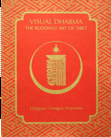Elements
of Iconography
Thangkas and other forms of Tibetan art express the vision of tantric
Buddhism. The subjects they depict are definite elements in that view
of the world.
Thangkas
and sculptured images fall into six general categories according
to their subject matter: 1) enlightened beings, 2) yidams, 3) dharmapalas,
4) mandalas and stupas, 5) illustrations of the teaching, 6) yantras.
The
iconography of tantric Buddhism, as all other aspects of it, is
inspired by the teaching of the five Buddha  principles:
vajra, ratna, padma, karma, buddha. These are the five basic energies
present everywhere. There are often known as the Buddha families.
Each is particularly associated with a certain ordinary emotion
which can be transmuted into a certain definite wisdom or aspect
of the awakened state of mind. The Buddha families are also associated
with colors, elements, directions, seasons, landscapes – with
any aspect of the phenomenal world. principles:
vajra, ratna, padma, karma, buddha. These are the five basic energies
present everywhere. There are often known as the Buddha families.
Each is particularly associated with a certain ordinary emotion
which can be transmuted into a certain definite wisdom or aspect
of the awakened state of mind. The Buddha families are also associated
with colors, elements, directions, seasons, landscapes – with
any aspect of the phenomenal world.
As has
been said, thangkas are mainly for the purpose of refining visualization,
which is a tantric or vajrayana meditation technique. The vajrayana
is the third and most advanced level of Buddhist spiritual training.
To arrive at this stage, students are expected first to undergo
intellectual and meditative training on the hinayana and Mahayana
levels. In hinayana they must understand the basic truths of egolessness,
impermanence and suffering as well as practice samatha and vipasyana
meditation. In mahayana, a competent master must show them a different
way of seeing reality, from the perspective of sunyata, or emptiness.
At this point,
tantric practice begins with the four foundation practices: one
hundred thousand prostrations, one hundred thousand repetitions
of the refuge formula, one hundred thousand repetitions of the one-hundred-syllable
Vajrasattva mantra, one hundred thousand presentations of mandala
offerings. Some schools also add one hundred thousand repetitions
of the bodhisattva vow. All of these tantric practices are accompanied
by a visualization.
Visualization
is not a magical practice nor worship of an external deity. It is
a process of identification with a particular principle of inspiration
and energy, with conviction in its presence. The visualization is
preceded and terminated by the sunyata experience, which dissolves
the ego’s tendency to hang onto something solid. It has been
said that visualizing without sunyata is dangerous; it accumulates
fixed ground for ego and leads to the achievement of egohood.
There is a progress
of sophistication in the practice of visualization as the practitioner
develops through the tantric levels of teaching. It begins with
regarding what is visualized as an object of devotion; the process
then becomes the acknowledgment of a transcendental presence; finally
visualization means unifying with the wisdom-body of a deity.
back
to top
...........................................................................................................................................................................................................
Essay © 1975 Chogyam Trungpa Rinpoche
copyright © 2003 Shelly and Donald Rubin Foundation
|

